The care and feeding of digital displays
This month we are reprinting in English (with translations into other languages) another article by one of the best experts in the field of digital advertising, Mr. Louis Brill. The article was published in magazine “Signindustry.com”. This time his message is: once your LED screen or OOH network are in place, what next?
For the efforts in planning, purchasing and presenting digital signage, the most important part of operating a digital display system is its content. In this respect, a media platform format to a great extent defines content. As such, a sign message on a roadside billboard is not the same message one would find inside a health care center, in a church or a mall.
Equally important is how the content is “shaped” for each type of digital display for as these message formats evolve into more disparate media platforms including electronic billboards, LCD displays, cell phones and computers, so must the content conform to each platform.
The science of planning and placing content is also an art form, and the care and feeding of digital displays is a complex dance of defining who your audience is, what you want to tell them, and how to tell them your messages in the limited amount of time you have in streaming across their display screens.
Thus we enter the world of content providers who deal with “information synthesis” and its worldwide distribution on digital displays everywhere. Content comes in many forms whether it's displayed on a “ticker crawl” on the bottom of your television or on a street side wall-mounted electronic message center. To understand the nature of content development, two companies recently interviewed discussed their efforts in keeping digital screens filled with interesting and important information for a curious public 24/7/365.
One information snippet that is an important part of our daily activity is the weather report, basically is it going to be an “umbrella day” or a sports coat day? Weather reports seem to appear everywhere as we quickly glance at them, note the forecast and plan accordingly. To gain some insight in how weather ticker content is mined and managed, Mike Welch, Director of Digital Signage Sales of Accuweather discussed it process of investigating and informing the public about that big question, “What's tomorrow's weather going to be like?”
“AccuWeather.com (State College, PA) is a privately held company founded 47 years ago as a weather consultation service. Over the ensuing decades AccuWeather.com has evolved through the diversification of media into nine different business services. This includes public displays (preparing content for digital signage and web sites), and other media forms such as television, radio, newspapers, cell phones, vehicle navigation systems, and mobile internet devices. There is also an advertising strategy where advertising is sold into AccuWeather.com segments in television and radio feeds.”
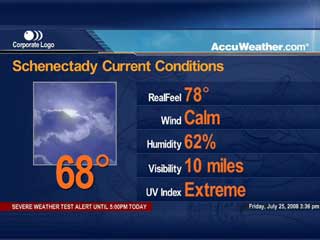 |
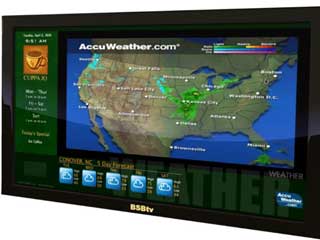 |
| Typical Accuweather templates for a local television weather report Photo credit: Accuweather.com |
|
Essentially AccuWeather.com collects and creates weather information analysis and then distributes it as forecasts out to its worldwide audience of consumers and businesses. “In terms of collecting this weather data,” says Welsh, “we ingest about half a terabyte of weather data a day which is processed through our proprietary weather modeling database - one of the first and still most sophisticated weather modeling systems of its kind. This raw data and modeling information is interpreted by over 100 meteorologists. As a result, we deliver the most accurate forecasts for over 2.7 million worldwide locations.”
“These forecasts are directed to every major city in the world - in fact nearly anywhere on Earth people live - where our forecasts are picked up by local television and radio stations, newspapers, Internet services and digital signage networks.”
“Our content is designed to grab the audience's attention and hold it as they view the accompanying advertising messages. We offer a wide range of weather content to suit the needs of most public display clients, but in some cases our digital signage and public display clients will require customized weather content. For example, we have a partner in Greece, Digital Signage and Marketing Services. In one instance they required a finished Flash module for their client's digital sign. However, the scope of the project didn't allow for ongoing Greek translations. Instead, we leveraged the client's own translations for weather text and were able to solve this challenge to deliver an attractive weather module in their native language with the look and feel they wanted for their client.”
In the realm of digital signage, Welsh noted that their weather forecasts serve all major media platforms with the highest concentration on indoors (mostly LCD displays) and outdoors LED screens. Site locations include everything from local banks with interior display screens in the waiting area to an audio visual sign integrator who does digital sign installations for retail chains - to the hardware/software provider who programs AccuWeather.com content to work for the customer right out of the box.
“Our content for signage extends well beyond weather through partnerships with content and media leaders such as the Associated Press (AP) which allows us to include US News, World News, Sports, Health, Business and Science/Technology content along with our weather feeds. Working with us as a single digital signage content vendor, our clients are able to give an up-to-date and complete news picture to their customers.”
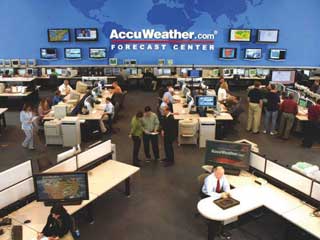 |
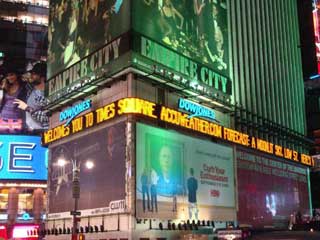 |
| Behind the wizard's curtain, at Accuweather's forecast center where weather on a world wide basis in mined Photo credit: Accuweather.com |
Times Square with its Dow Jones sign, one of Accuweather's most famous locations for its up-to-the-minute weather report Photo credit: Accuweather.com |
As more corporations and institutions become comfortable with digital signage, so do more companies see digital signage as a way of communicating with customers and staff. Naturally as these digital sign networks are installed, so is the content developed which is specific to each of these client situations.
One such company that handles custom digital display content is Rise Displays (Shawnee, KS) who is a content developer/digital sign integrator. The company creates content for several electronic sign formats including interactive digital signage, digital signage, LED screens and video walls. As noted by Ryan Cahoy, Managing Director for the company, “Rise Displays plays many roles for our clients as a content designer. We distribute existing content by accepting various formats of media assets from our clients, we fine tune the message and then feed publish it onto their existing digital sign network. If a client doesn't have existing media we can initiate designing the content from scratch based on their guidance and requirements to ensure the message is captivating.”
“Sometimes one situation evolves into the other, a client may have an existing advertizing agency which they lose, and we come in and take over. Or the opposite is true where we've been doing their creative and eventually they build an in-house staff and begin to do that on their own. However it gets crafted, we're there to support them and orchestrate their visual presence with their digital displays.”
In many cases corporate and institutional digital display networks are like snowflakes as no two digital sign systems are alike. They all have unique hardware configurations, the all have their own message content demands, all which result in unique content presentations. To illustrate this dynamic, Cahoy offered several Rise Displays case histories of projects they've worked on each with its own unique digital display solution.
The ING DIRECT Cafe, located across the US, is a place where you can sip a latte, surf the Internet and learn how ING can help you save your money with wise financial investments. ING Direct decided in reaching out to their customers they wanted to create a business model that was outside the norm of usual banking culture. What they defiantly did NOT want was to become just another bank. Their vision was to create a banking facility where their customers could enter into a more personable work space. Thus they came up with a business model that combined their financial service center with a cafe.
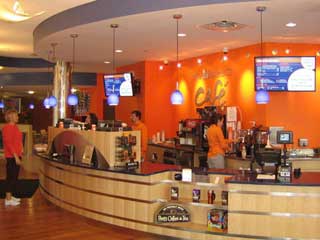 |
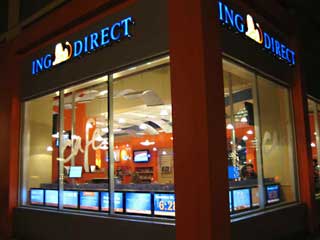 |
| Once customers enter an ING Direct cafe, they encounter the cafe menu board with a variety of drink selections and beverage pricing on those drinks Photo credit: Rise Displays |
|
Within their cafe, digital signage played a very important part of how ING communicated with their customers, as it became a very effective way of setting up a banking atmosphere and also attracting customers to the cafe. Rise Displays was the sign integrator that helped to create and operate their cafe digital displays and Cahoy observed that. “In setting up the displays, it was a multi-tier approach with at least four levels of signage. It all began with the “window attractor”, where digital signage was placed in the store windows to create a curiosity both about ING and the cafe.
“Once they entered the cafe, visitors encountered the cafe menu board with the various drink selections and beverage pricing on those drinks. On a more personal level was the “Interactive Information Center” which was a learning space that was composed of a touch screen and three big LCD displays. This allowed people to review the various financial services (IRAs, CDs, paperless banking and mortgage and brokerage services) and self select what they wanted to learn about. In turn, once selected a narrative would play out discussing that service. Finally some general digital display that was spread throughout the cafe which present scrolling ticker displays of your - typical news, sports, weather and financial information.”
Cahoy noted that, “ING was happy enough with the pilot cafe that they carried the idea forward and have opened other ING Direct cafe branches in New York City (two), Los Angeles, Honolulu, Chicago, and Philadelphia. As we set up each of these sites, each one became a little more sophisticated. One thing we've learned from all of this is that interactivity and digital signage are becoming more prevalent. We're using more touch screens and becoming more clever in how we engage the customers to become more involved with the products and services of ING Direct.”
 Digital displays in various public gathering areas around the hospital
Digital displays in various public gathering areas around the hospitalPhoto credit: Rise Displays
In another client location, the Heritage Valley Heath System is a progressive community-based healthcare system located in southwestern Pennsylvania. In an effort to expand their service and communication to their patients, visitors and staff, the Heritage hospital started by setting up digital displays in the main lobby area of the hospital and as well in the emergency waiting room. In this setting, the hospital presented an introductory video about itself and the different health services it offered to the community. In time as they found the initial digital displays well received by the public, they expanded to also communicate with their staff by installing displays in their cafeteria as well. All of the content is designed and managed in house by their multi-media director to ensure a cohesive and consistent message across all areas of the healthcare provider.
Heritage Valley Health System is a progressive community-based healthcare system who set up a series of digital displays in their various public gathering areas around the hospital. The displays present introductory videos about itself and the different health services they offer to the community.
In developing digital sign content, one could do well to follow the Three Rules of V, digital content should be viral (sign messages are compelling and “instinctive” to draw customers to the signage), visceral (content is interactive via touch screens) and virtual (display content is designed to be “cross platform” for digital signs to the Internet, and if the market demands it, to cell phones). As digital displays become more ubiquitous, so are they becoming more a part of public space. Indeed, they appear everywhere building walls to store front windows, all with a clear cut emphasis that “content is king” Done right, it can act as educator, a sales assistant or a proselytizer for your business. In the end, good content should create new customers and from that, new business.





